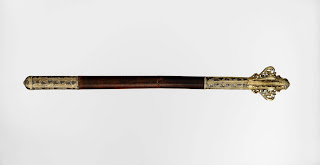Set of Turkish Quiver, Bow case and Arrows
Set of Turkish Quiver, Bow case and Arrows
Turkish Bow case
“Sadak” and Quiver “Tirkeş” set. Made of, Leather with appliqués, silk threads,
silk fabric and gold leaf, ca. 1550. The bow, which was stowed in the bow case,
had become a symbol of Turkish armament alongside the Kilij. Depending on the quality
of the bow, it took up to ten years to manufacture the weapon, with individual
layers of wood, buffalo horn, and sinew (tendon) glued together with fish glue.
Each of these operations required extensive drying times, resulting in the long
manufacturing time. The Turkish army did not renounced this weapon even after
the introduction of firearms. With these composite bows, the Turks shot up to
800 meters. In order to protect the bow from moisture, after use, it was stored
in a Sadak, which was worn on the left side. Sadak also made it possible to
stow the bow in close combat, as it was a hindrance. On the other hand a
“Tirkeş” (Quiver) was a container for holding the arrows, which was worn on the
right side.
 |
| Quiver "Tirkeş" and Arrows |
 |
| Bow case "Sadak" |
Türk Tirkeş, Sadak Takımı ve Oklar
Aplike deri, ipek iplik, ipek kumaş ve altın varaktan mamul, Türk Sadak
ve Tirkeş takımı, 1550 civarı. Sadakta muhafaza edilen yay, kılıç ile birlikte
Türk silah donanımının bir simgesi haline gelmişti. Türk ordusu ateşli
silahların kullanımından sonra bile bu silahtan feragat etmedi. Balık tutkalı
ile yapıştırılmış, bir birinden farklı ahşap, manda boynuzu ve sinir (tendon)
katmanlarından oluşan silahı üretmek yayın kalitesine bağlı olarak on yıl kadar
alıyordu. Bu işlemlerin her biri, uzun üretim süreleriyle sonuçlanan kapsamlı
kurutma zamanı gerektiriyordu. Bu katışık yaylar ile Türkler 800 metreye kadar
atış yaparlardı. Kullanımdan sonra, nemden korumak için, yay sol tarafa takılan
bir Sadak içinde muhafaza edilirdi. Sadak, ayrıca yakın dövüşte, bir engel
olacağı için, yayı istiflemeyi de mümkün kılardı. Öte yandan Tirkeş ise, sağ
tarafa takılan, okların muhafaza edildiği bir kılıftı.


Comments
Post a Comment